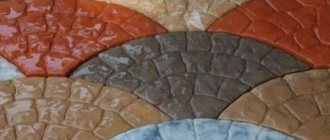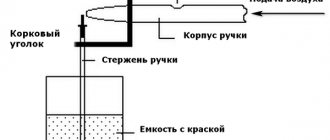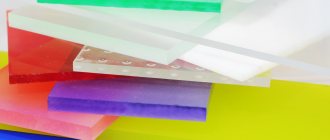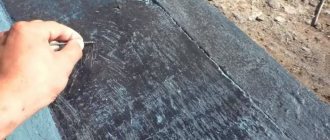Acrylic sealant - what type of sealant is it?
First, let’s figure out what types of sealing materials there are and what their fundamental differences are. We’ll also find out what type of acrylic sealant is. One type of dividing sealants is based on the degree of hardening of the composition after its application:
- Non-hardening compounds - sealants do not change their amorphous state after application, for example, ordinary plasticine, familiar to us from childhood, is a prominent representative of this category of sealants.
- Hardening compounds - after application, a chemical polymerization reaction (vulcanization) occurs and the sealing compound becomes solid. A typical representative of this class is silicone sealant.
- Drying compositions - here hardening occurs as a result of the evaporation of water from the sealing composition. Acrylic sealant belongs to this type.
Acrylic sealant: chemical composition.
Acrylic sealant is a water-dispersion composition, the main component of which is polymethyl methacrylate. Polymethyl methacrylate is a synthetic polymer with very interesting properties. People know it by its simpler name - plexiglass. Acrylic sealant also includes:
- plasticizers are substances that give the sealant the necessary elasticity;
- defoamers are substances that prevent or reduce the formation of foam;
- Thickeners - these substances give the desired consistency;
- fillers - these substances change the physical properties of acrylic sealant;
- antiseptics.
Acrylic sealant: technical characteristics.
Acrylic sealant remains elastic for a long time, adapting to various types of vibrations, which is a definite plus. Possessing excellent adhesion, the sealant sticks to literally everything - wood, concrete, stone, metal. Also, acrylic sealant can be easily painted and plastered - unlike other types of sealants (silicone, polyurethane).
Another amazing property of acrylic sealant is the memory of the material. With any stretching or compression, the sealant tries to return its shape to its original position. The higher the quality of the acrylic sealant, the higher its specific stretch coefficient; for example, acrylic sealant for wood Ramsauer Acryl 160 can stretch 6-7 times before breaking.
Acrylic sealant for exterior use
Acrylic sealant for exterior use is made using a special recipe. It contains additives that give the acrylic sealant frost resistance. Unlike conventional acrylic sealants, this composition can be used at temperatures ranging from -20°C. Such acrylic sealants will withstand more than one freeze-thaw cycle, which is an undeniable advantage in Russian climatic conditions.
All acrylic sealants are initially colorless, i.e. are transparent. But since the use of acrylic sealants involves working on wood or concrete, they are tinted at the factory. Primary colors are white, grey, beech, oak, safari, etc.
Acrylic sealant: pros and cons.
What are the advantages of acrylic sealant, let's look at them:
- Price . Solutions based on acrylic sealants are on average one and a half to two times cheaper than using silicone compounds.
- Ease of use . When working with the material, acrylic sealant is easily applied and, if necessary, adjusted with ordinary warm water.
- Environmental friendliness . The composition does not contain harmful impurities such as hypoallergens, toxins, etc. Acrylic sealant is also fire and explosion proof.
- Versatility. Acrylic sealant adheres to almost any surface.
- Vapor permeability.
Well, now let's look at the disadvantages of acrylic sealants.
First of all, they are not very friendly with water, especially at the stage of application to the material. Since the composition is based on an aqueous dispersion, it is easily washed off before it has time to harden. Also, acrylic sealant does not like constant contact with water. Therefore, using it to seal aquariums, for example, is not allowed, as it will leak over time. Although acrylic sealants are also moisture resistant. They acquire this property after complete drying. Therefore, external work with acrylic sealant should be carried out in weather without rain or snow. Perhaps this is where the disadvantages of acrylic sealants end.
Acrylic sealants: features of application.
As a rule, acrylic sealants are sold in tubes, file bags or in buckets. It is very convenient to use a special gun to apply sealant. It will significantly reduce the time of applying acrylic sealant, unlike if you did it manually with a spatula.
When sealing deep cracks and seams, it is wise to use special cords. They will not only significantly save sealant consumption, but will also give it the necessary support point, which will additionally have a positive effect on the quality of sealing.
It is also necessary to ensure that the working surface is as clean as possible and free of visible moisture. By following these simple rules, the entire process of applying sealant will not be difficult.
Acrylic sealant: scope of application.
Acrylic sealants are mainly used at the interface between low-moving and fixed parts.
Here are the main areas:
- sealing interpanel seams;
- sealing cracks in walls;
- sealing pipe joints;
- sealing of inter-crown seams;
- sealing cracks in wood;
- installation of windows and doors
And much more. After all, acrylic sealant is truly a universal product.
It, like all similar materials, is also divided into conditional categories. For example, acrylic sealant for wood or concrete, acrylic sealant for exterior or interior use, frost-resistant and non-frost-resistant. There are many such divisions that can be given, but this does not exclude the versatility of acrylic sealant.
You can buy all the necessary materials and tools for working using the warm seam technology in our store:
How can I use the form?
Make a mold for the paving stones of the desired model. Then all you have to do is prepare the cement and add it to the paving mold. After 5 minutes, all you have to do is remove the excess. That's all, you just need to repeat the operation as many times as necessary to get a uniform cobblestone path. Be careful, the cement must be allowed to dry for a week before it can be used to lay a path or create a plant pot from it.
If the area requires raising to a higher level, then the rise should be built by adding a foundation layer rather than by increasing the thickness of the bedding layer.
Note!
- How to make a hot smoked smokehouse - 75 photos of the best ideas and step-by-step instructions
Feeder for chickens - ideas, description of construction and features of creating feeders from scrap materials
Bathhouse in the country: TOP 100 photos of the best options. Step-by-step description of how to build different types of baths with your own hands
For roadways or other intensive use, the base layer is load-bearing and must be at least 100 mm thick. For public footpaths this value may sometimes be reduced to 75 mm or increased to 150 mm or more to provide additional protection for underground services.
When working, do not use construction sand. When overmoistened, moving under the slabs, it causes the path to settle. It may contain minerals that will stain certain types of pavement.
Tips for production and operation
To make template elements last longer, you need to adhere to the following recommendations:
- If a matrix form is planned, then it is advisable to maintain a slight slope of the walls to the outside.
- The thickness of the walls of plastic products should be cast such that it can withstand the pressure of the solution when carried.
- Templates made of wood and plaster should preferably be coated with paint and varnish. It is recommended to periodically treat wooden dies with paints and varnishes to prevent destruction and deformation of the stencils.
- Instead of cast stencils, you can use scraps of plastic pipes and old plastic containers.
- Before use, it is recommended to lubricate template products with used machine oil or special compounds to make it easier to remove the cast tile elements.
- When creating stencils, it is advisable to also make corner elements so as not to cut finished fragments.
- To make it easier to transfer the pouring from the vibrating table to the platform for hardening products, stencils can be made with handles.
If you follow the above recommendations, then hand-made templates for paving slabs will last longer.
Decorative forms for imprints
Molds for cement with markings allow you to visualize paving slabs, stone, wood. The forms, both rigid and flexible, can be easily adapted to the configuration of the work being performed (garden path, sidewalk, courtyard).
A wide selection of mold models offer complete customization to create your environment (pool deck, walkway, driveway, patio and more). A mold for a stone imprint, a mold for a wood imprint – you just need to choose and start making.











